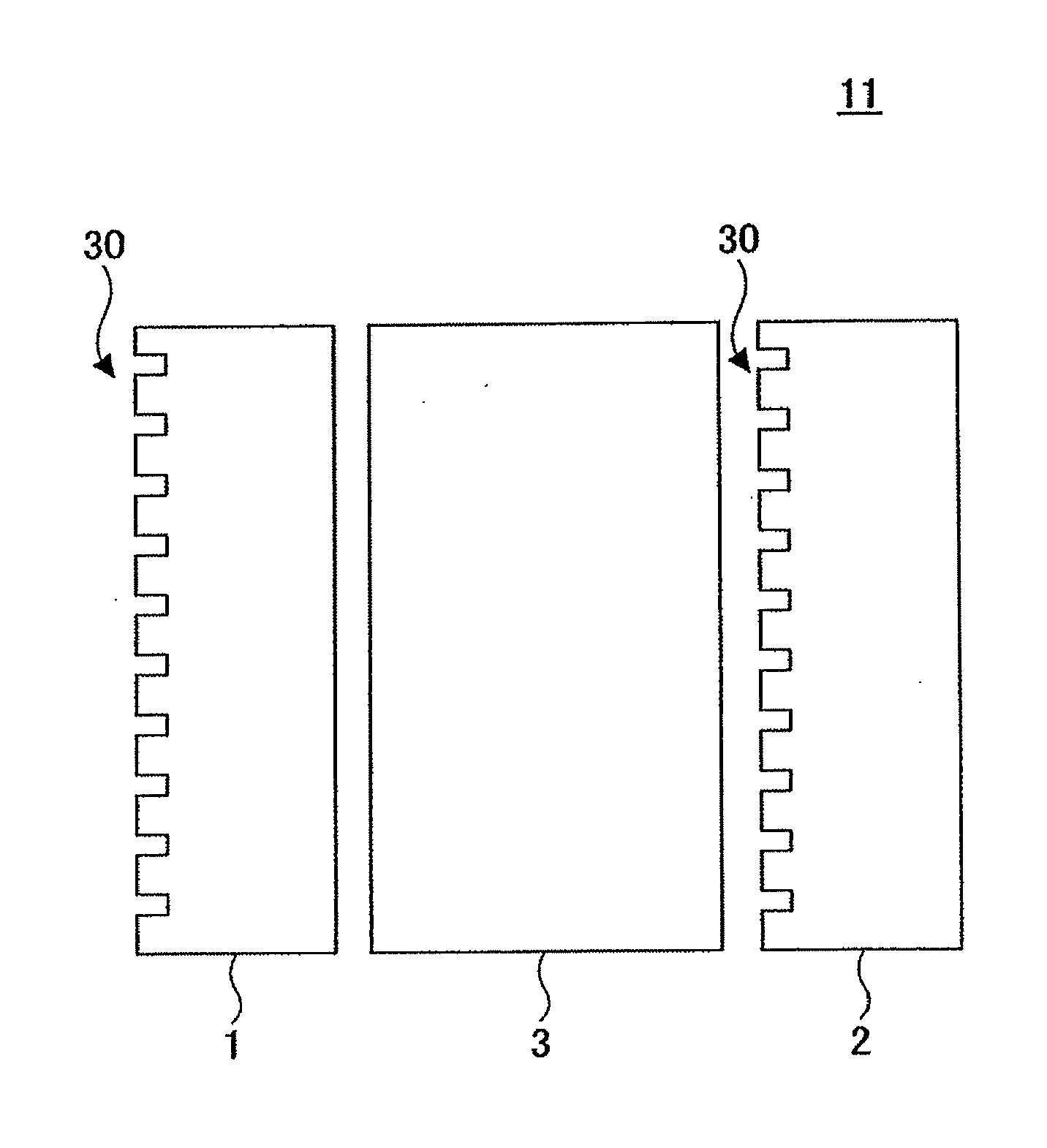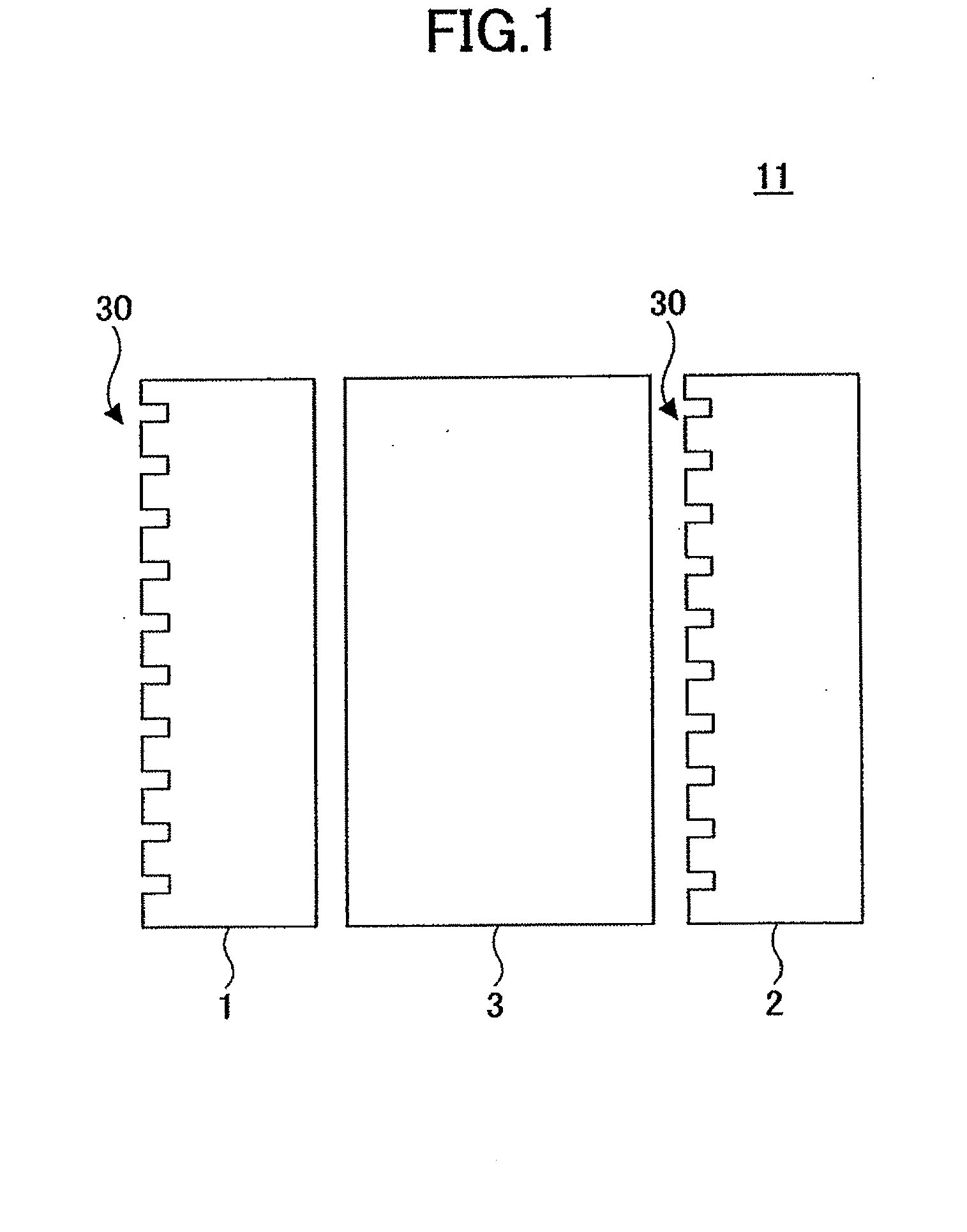Optical element, polarization filter, optical isolator, and optical apparatus
- Summary
- Abstract
- Description
- Claims
- Application Information
AI Technical Summary
Benefits of technology
Problems solved by technology
Method used
Image
Examples
embodiment 1
[0037]FIG. 1 is a schematic illustration of an optical isolator 11 according to an embodiment of the present invention. The optical isolator 11 includes a first polarization filter 1, a second polarization filter 2, and a 45° Faraday rotator 3 that are arranged in parallel and fixed to one another, using an adhesive, for example. The first and the second polarization filters 1 and 2 each include a diffracting surface 30 (diffracting structure) on one side. In the following description, for convenience's sake, a polarization direction perpendicular to the plane of the sheet of the drawing may be referred to as a P-polarized direction and a polarization direction within the plane of the sheet of the drawing may be referred to as a S-polarized direction. The first and the second polarization filters 1 and 2 are of a transmitting-diffraction type. The optical isolator 11 is disposed substantially perpendicular to the optical axis of incident light.
[0038]The first and t...
embodiment 2
[0051]Next, an optical isolator according to another embodiment of the present invention is described. Because the polarization filter function can be realized by the diffracting structure alone formed on an optical element, an optical isolator structure illustrated in FIG. 6 may be employed. Specifically, a diffracting surface (diffracting structure) 31 having the function of the first polarization filter 1 may be formed on a surface on the incident side of the Faraday rotator 3, and a diffracting surface (diffracting structure) 32 having the function of the second polarization filter 2 may be formed on a surface on the emerging side of the Faraday rotator 3. The diffracting structures 31 and 32 may be directly formed on the surfaces of the Faraday rotator 3, or the surfaces of the Faraday rotator 3 may be initially coated with a separate material, and then the diffracting structures 31 and 32 may be formed on the coated surfaces. Thus, in accordance with the pres...
embodiment 3
[0053]FIG. 7 illustrates an optical isolator 11 in which the structures according to Embodiments 1 and 2 are combined. The optical isolator 11 illustrated in FIG. 7 includes a Faraday rotator 3 on both sides of which the diffracting structures 702 including the subwavelength concave-convex structures are formed after coating the sides with a separate material. The first and the second polarization filters 1 and 2 including the corresponding subwavelength concave-convex structures 701 formed on corresponding substrates 704 are then disposed opposite the corresponding diffracting structures 702. Gap retainers 703 may be provided between the opposing diffracting structures 701 and 702 in order to maintain predetermined gaps between them.
[0054]While the diffracting structures 701 of the first and the second polarization filters 1 and 2 may not be disposed facing each other, doing so prevents the exposure of the diffracting structures 701 to the outside, thereby preventing the diffractin...
PUM
 Login to View More
Login to View More Abstract
Description
Claims
Application Information
 Login to View More
Login to View More - R&D
- Intellectual Property
- Life Sciences
- Materials
- Tech Scout
- Unparalleled Data Quality
- Higher Quality Content
- 60% Fewer Hallucinations
Browse by: Latest US Patents, China's latest patents, Technical Efficacy Thesaurus, Application Domain, Technology Topic, Popular Technical Reports.
© 2025 PatSnap. All rights reserved.Legal|Privacy policy|Modern Slavery Act Transparency Statement|Sitemap|About US| Contact US: help@patsnap.com



